
The European Union and Italy are home to a number of microstates. These are fully independent countries and a few are not members of the EU.
However, many of Europe’s smallest countries are a de facto part of the Schengen Area. This means visitors will need to apply for an ETIAS visa waiver to visit them from 2026.
Knowing when to have an ETIAS in advance will be essential to planning a successful trip. Read on below to learn which microstates can be visited with a valid visa waiver.
Microstates in Italy: is an ETIAS required?
Italy has 2 microstates within its borders. These both existed before the foundation of the modern state of Italy in 1848 and have remained independent since. Neither is a member of the EU.
However, neither of the microstates located in Italy has its own port or airport. This means it is necessary to transit through Italy to arrive in either of them.
Nationals of countries meeting the correct Europe entry requirements will need to hold a valid ETIAS visa waiver to pass through Italy to get to either of the microstates.
Find out more about these nations below.
Vatican City: The world’s smallest country
Vatican City is the world’s smallest county. It covers only 0.5 km² in central Rome and is a major tourist destination. As the seat of the Pope and the Holy See, it is perhaps the most significant landmark for Catholics all over the world.
San Marino: The world’s oldest continuous state
San Marino has been in continuous existence since 301 CE and is one of the oldest independent nations in the world — in fact, it has remained an independent nation longer than any other country on Earth today. It is a small, mountainous, and landlocked country located near Florence, covering approximately 61 km².
Other microstates in the Schengen Area
Italy is far from the only Schengen member with micronations within its borders. There are 4 other microstates found in European countries and the Mediterranean, which can be visited with an ETIAS visa waiver.
Monaco: principality on the shores of the Mediterranean
Monaco is a principality found on the southern coast of France, close to the border with Italy. It is the world’s second-smallest country, covering only 2 km² and is well known for hosting motorsport events such as the yearly Monaco Grand Prix.
It is possible to access the country from France, or by boat. Monaco is not a member of the EU or Schengen, yet shares open borders with France and is therefore assumed to be part of the passport-free zone.
Liechtenstein: the alpine micronation
Liechtenstein is a small landlocked country found in the Alps between the borders of Switzerland and Austria. It only measures around 161 km² and is popular for its winter sports and picturesque landscape.
The country is part of the Schengen Area, and is only accessible via one of the bordering countries due to its double-landlocked location and lack of an airport. It is necessary to have an ETIAS visa waiver to visit Lichtenstein for this reason.
Andorra: the Pyrenees principality
Andorra is a country measuring 468 km² in size that sits on the borders of both Spain and France, high up in the Pyrenees mountains. It is often visited for its tax-free shopping and ski resorts, as well as its close proximity to Barcelona.
It is not part of the EU or Schengen and requires border checks to enter. However, visitors will need an ETIAS visa waiver to arrive in Andorra from one of its neighbouring countries.
Malta: island microstate
Malta is the smallest nation in the European Union. The country is situated on an island located off the southwest coast of Sicily. It measures just 316 km² across and, despite being a full EU member, is smaller than some of the other nations listed above that haven’t joined.
The island nation is also a member of Schengen and it is necessary to hold a valid ETIAS visa waiver if visiting from a non-EU or EFTA country. Due to its popularity with tourists, it is accessible by both direct flights or by boat or cruise ship.
In addition to the independent states listed above, another small territory in Europe is in talks to join the Schengen Area: Gibraltar.
Gibraltar may still be British but it is planning to become part of the Schengen area and will require travellers from outside the EU to hold an ETIAS to visit. These negotiations started in 2021 when the United Kingdom left the European Union following Brexit.
Europe and Italy are far from unique for having microstates within their borders, although they are notable for having some of the smallest and oldest independent states in the world.


